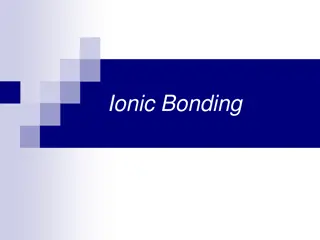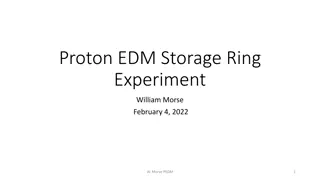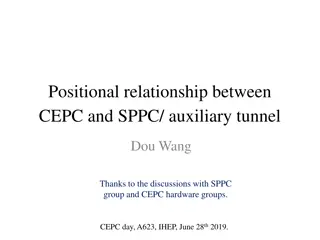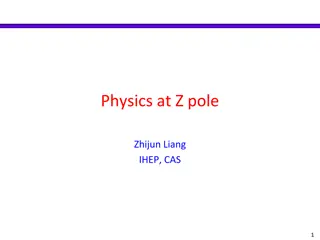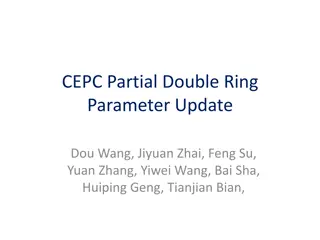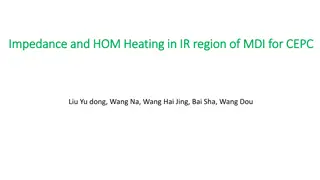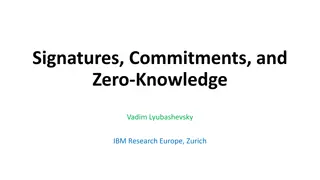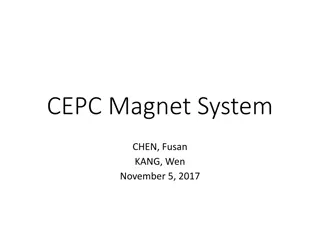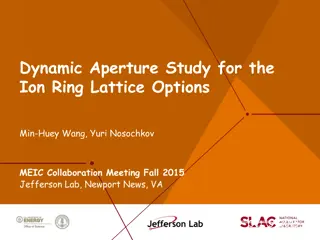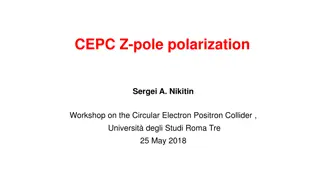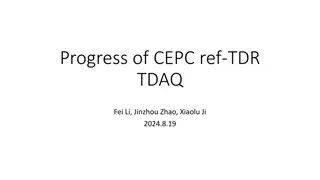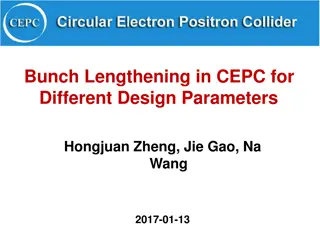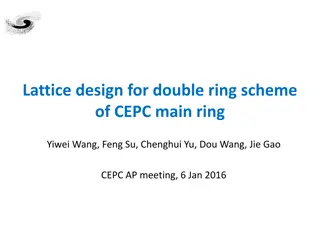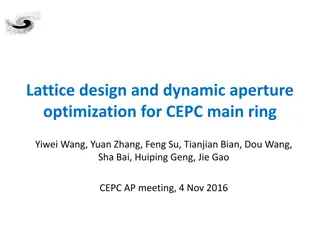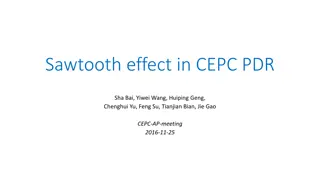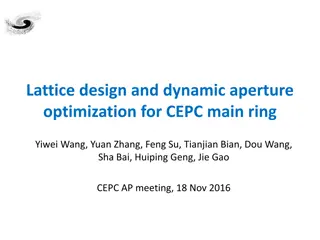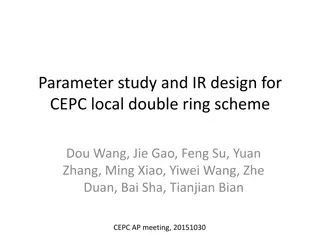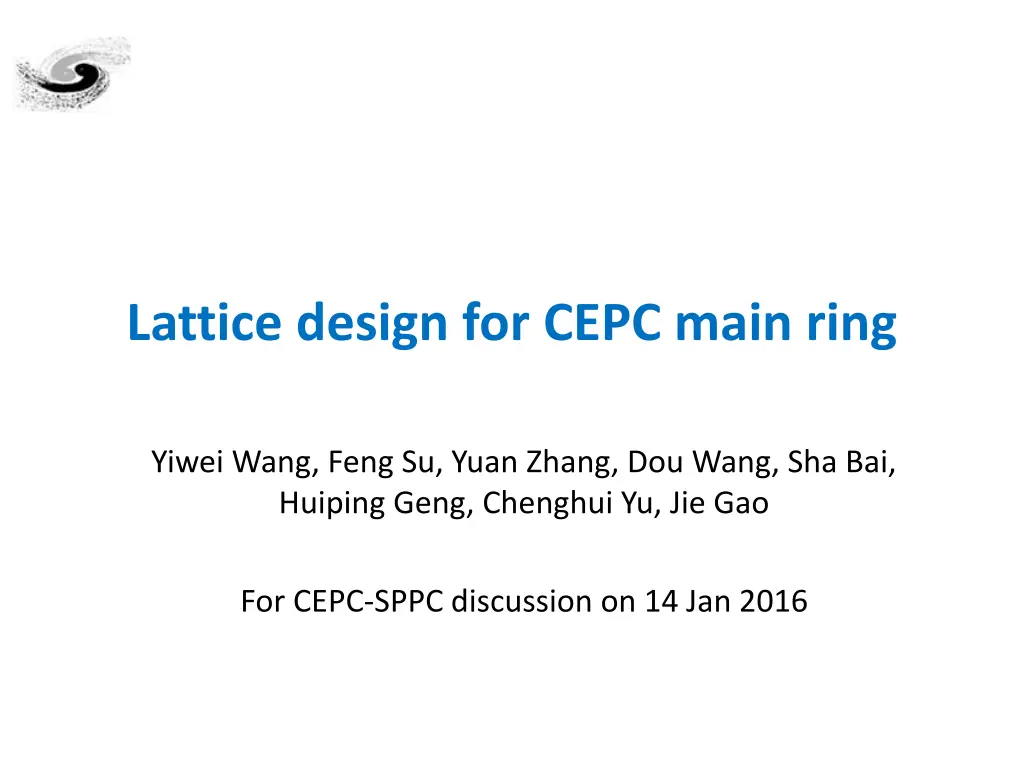
CEPC Main Ring Lattice Design and Parameters Overview
Explore the lattice design, parameters, and geometry of the CEPC main ring, including details on the double ring scheme, CEPC parameters for a 100 km ring, lattice design for ARC region, and the RF region setup. Check out visual representations and technical insights for the future collider project.
Download Presentation

Please find below an Image/Link to download the presentation.
The content on the website is provided AS IS for your information and personal use only. It may not be sold, licensed, or shared on other websites without obtaining consent from the author. If you encounter any issues during the download, it is possible that the publisher has removed the file from their server.
You are allowed to download the files provided on this website for personal or commercial use, subject to the condition that they are used lawfully. All files are the property of their respective owners.
The content on the website is provided AS IS for your information and personal use only. It may not be sold, licensed, or shared on other websites without obtaining consent from the author.
E N D
Presentation Transcript
Lattice design for CEPC main ring Yiwei Wang, Feng Su, Yuan Zhang, Dou Wang, Sha Bai, Huiping Geng, Chenghui Yu, Jie Gao For CEPC-SPPC discussion on 14 Jan 2016
CEPC parameters for C=100km wangdou20161202-100km Pre-CDR H-high lumi. H-low power W Z Number of IPs Energy (GeV) Circumference (km) SR loss/turn (GeV) Half crossing angle (mrad) Piwinski angle Ne/bunch (1011) Bunch number Beam current (mA) SR power /beam (MW) Bending radius (km) Momentum compaction (10-5) IPx/y (m) Emittance x/y (nm) Transverse IP(um) x/ y/IP RF Phase (degree) VRF(GV) fRF(MHz) (harmonic) Nature z(mm) Total z(mm) HOM power/cavity (kw) Energy spread (%) Energy acceptance (%) Energy acceptance by RF (%) n Life time due to beamstrahlung_cal (minute) F (hour glass) Lmax/IP (1034cm-2s-1) 2 2 2 2 2 2 120 54 3.1 0 0 3.79 50 16.6 51.7 6.1 3.4 120 100 1.67 15 2.9 0.97 644 29.97 50 11 1.3 120 100 1.67 15 2.9 0.97 425 19.8 33 11 1.3 80 100 0.33 15 3.57 1.05 1000 50.6 16.7 11 3.1 45.5 100 0.034 15 5.69 0.46 10520 232.1 8.0 11 3.3 0.12/0.001 0.93/0.0049 10.5/0.07 0.0075/0.054 160.8 0.11 45.5 100 0.034 15 5.69 0.46 65716 1449.7 50 11 3.3 0.12/0.001 0.93/0.0049 10.5/0.07 0.0075/0.054 160.8 0.11 0.8/0.0012 6.12/0.018 69.97/0.15 0.118/0.083 153.0 6.87 650 2.14 2.65 3.6 (5cell) 0.13 2 6 0.23 47 0.144 /0.002 1.56/0.0047 15/0.097 0.0126/0.083 131.2 2.22 650 (217800) 2.72 2.9 0.64 (2cell) 0.098 1.5 2.2 0.26 52 0.144 /0.002 1.56/0.0047 15/0.097 0.0126/0.083 131.2 2.22 650 (217800) 2.72 2.9 0.42 (2cell) 0.098 1.5 2.2 0.26 52 0.1 /0.001 2.68/0.008 16.4/0.09 0.0082/0.055 149 0.63 650 (217800) 3.8 3.9 1.0 (2cell) 0.065 650 (217800) 3.93 4.0 3.93 4.0 1.0 (1cell) 0.037 6.25(1cell) 0.037 1.5 0.26 1.1 0.18 1.1 0.18 0.68 2.04 0.95 3.1 0.95 2.05 0.84 4.08 0.91 11.36 0.91 70.97
Lattice design and geometry for ARC region FODO cell, 90 /90 , non-interleaved sextupole scheme period N=5cells all 3rd and 4th resonance driving terms (RDT) due to sextupoles cancelled, except small 4Qx, 2Qx+2Qy, 4Qy, 2Qx-2Qy tune shift dQ(Jx, Jy) is very small DA on momentum: large Chromaticity dQ( ) need to be corrected with many families DA off momentum: with many families to correct dQ( ) and I break down Bin=12576 m Bout=12576.6 m - -I I - -I I Sextupole configuration
Lattice design and geometry for RF region Public RF region for e- and e+ ring An electrostatic separator, combined with a dipole magnet to avoid bending of incoming beam (ref: Oide, ICHEP16) Deviation of outgoing beam is x=0.6 m, =0 combined magnet public RF region
Lattice design and geometry for interaction region Provide local chromaticity correction for only vertical plane Keep ARC sextupoles and final doublet on phases for horizontal chromaticity correction Crossing angle 30 mrad geometry of IR L*= 1.5m x*= 0.144mm y*= 2mm GQD0= -200T/m GQF1= 200T/m LQD0=1.69m LQF1=0.90m IR of IP upstream Ec < 100 keV within 280m IR of IP downstream Ec < 500 keV within 200m
Lattice design of whole ring Length=100624.25 m Qx=307.08 Qy=307.22 x=1.8 nm L*= 1.5 m x*= 0.144 mm y*= 2 mm crossing angle=30 mrad
Geometry of whole ring Length=100624.25 m Qx=307.08 Qy=307.22 x=1.8 nm L*= 1.5 m x*= 0.144 mm y*= 2 mm crossing angle=30 mrad
Preliminary result of dynamic aperture Dynamic aperture study Bare lattice Synchrotron motion included w/o damping Tracking with around 1 times of damping time Coupling factor =0.003 for y Working point (0.08, 0.22) Possible optimization for on- momentum DA tune the beta functions @crab sextupoles to get a target DA shape 20 x 40 y further work on DA study for double ring scheme is undergoing w/o crab sextupole w/ crab sextupole
parameter for CEPC partial double ring wangdou20160918 Pre-CDR H-high lumi. H-low power W Z Number of IPs Energy (GeV) Circumference (km) SR loss/turn (GeV) Half crossing angle (mrad) Piwinski angle Ne/bunch (1011) Bunch number Beam current (mA) SR power /beam (MW) Bending radius (km) Momentum compaction (10-5) IPx/y (m) Emittance x/y (nm) Transverse IP(um) x/IP y/IP VRF(GV) fRF(MHz) Nature z(mm) Total z(mm) HOM power/cavity (kw) Energy spread (%) Energy acceptance (%) Energy acceptance by RF (%) n Life time due to beamstrahlung_cal (minute) F (hour glass) Lmax/IP (1034cm-2s-1) 2 2 2 2 2 120 54 3.1 0 0 3.79 50 16.6 51.7 6.1 3.4 120 61 2.96 15 1.88 2.0 107 16.9 50 6.2 1.48 120 61 2.96 15 1.84 1.98 70 11.0 32.5 6.2 1.48 80 61 0.58 15 5.2 1.16 400 36.5 21.3 6.2 1.44 45.5 61 0.061 15 6.4 0.78 1100 67.6 4.1 6.2 2.9 0.1/0.001 0.88/0.008 9.4/0.089 0.01 0.072 0.11 650 3.78 4.0 0.99 0.05 0.8/0.0012 6.12/0.018 69.97/0.15 0.118 0.083 6.87 650 2.14 2.65 3.6 0.13 2 6 0.23 47 0.272/0.0013 2.05/0.0062 23.7/0.09 0.041 0.11 3.48 650 2.7 2.95 0.74 0.13 2 2.3 0.35 37 0.275 /0.0013 2.05 /0.0062 23.7/0.09 0.042 0.11 3.51 650 2.7 2.9 0.48 0.13 2 2.4 0.34 37 0.1/0.001 0.93/0.0078 9.7/0.088 0.013 0.073 0.74 650 2.95 3.35 0.88 0.087 1.7 0.49 1.2 0.34 0.68 2.04 0.82 3.1 0.82 2.01 0.92 4.3 0.93 4.48 11
Lattice design for ARC region FODO cell, 90 /90 , non-interleaved sextupole scheme period N=5cells all 3rd and 4th resonance driving terms (RDT) due to sextupoles cancelled, except small 4Qx, 2Qx+2Qy, 4Qy, 2Qx-2Qy tune shift dQ(Jx, Jy) is very small DA on momentum: large Chromaticity dQ( ) need to be corrected with many families DA off momentum: with many families to correct dQ( ) and I break down - -I I - -I I Sextupole configuration
Lattice design for interaction region Local chromaticity correction with sextupoles pairs separated by I transportation all 3rd and 4th RDT due to sextupoles almost cancelled up to 3rd order chromaticity corrected with main sextupoles, phase tuning and additional sextupoles tune shift dQ(Jx, Jy) due to finite length of main sextupoles corrected with additional weak sextupoles Break down of I, high order dispersion could be optimized with odd dispersion scheme or Brinkmann sextupoles MT CCX CCY FT IP L*= 1.5m x*= 0.22mm y*= 1mm GQD0= -200T/m GQF1= 200T/m LQD0=1.69m LQF1=0.90m - -I I - -I I
Lattice design for PDR region Feng Su, Yiwei Wang Yiwei Wang CEPC-SppC Study Group Meeting 14
Lattice design for whole ring A lattice of the whole ring (ARC+PDR+IR) basically fulfilling the design parameters
Target of CEPC dynamic aperture Parameter Symbol Unit Value 1034cm-2s-1 Luminosity per IP Lmax x/ y x/ y x/ y 2.01 Beta functions at IP m 0.275 /0.0013 nm rad nm rad nm rad Main ring emittance 2.05 /0.0062 Injection emittance 3.5 / 0.17 Transvers acceptance* Ax/Ay 787 / 4.17 Energy acceptance DA requirement from beam-beam (inclu. errors and beam-beam effect) DA requirement from injection (inclu. errors and beam-beam effect) AE % 2.0 20 / 40 (dp/p=0) 5 / 10 (dp/p= 2%) 20 / 26 (dp/p=0 and dp/p= 0.5%) DAx/DAy DAx/DAy Based on the parameters wangdou20160918 H-low power . *assuming coupling factor =5% for injection beam, x,r=200 m, x,i=60 m, ws = 4 mm, nr = 5, ns = 5
Optimization of dynamic aperture Dynamic aperture study Bare lattice Synchrotron motion included w/o and w/ damping Tracking with around 1 times of damping time Coupling factor =0.003 for y Working point (0.08, 0.22) Downhill Simplex algorithm applied Further optimization is possible Larger dispersion for IR sextupoles y*= 1mm -> 2mm (new parameters) More families in IR Study of effects such as sawtooth, errors and misalignments, quantum excitation, solenoid field are under going

